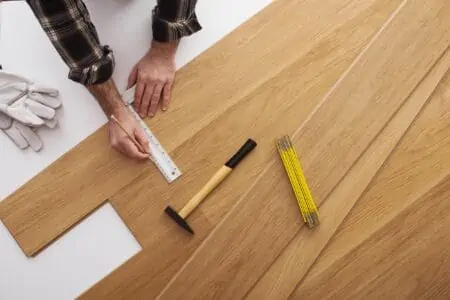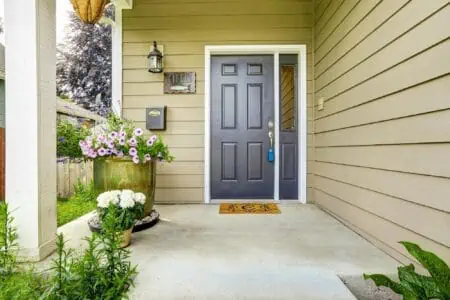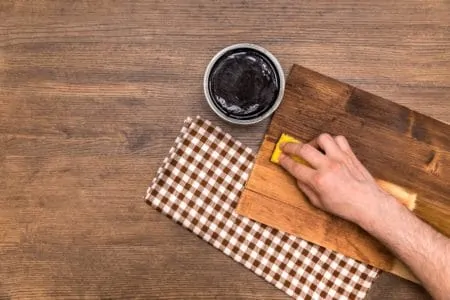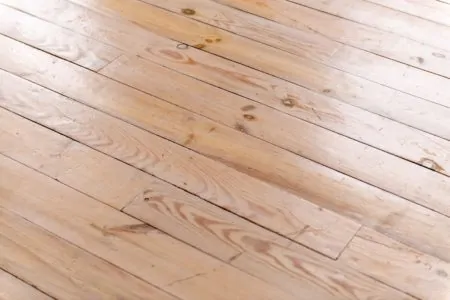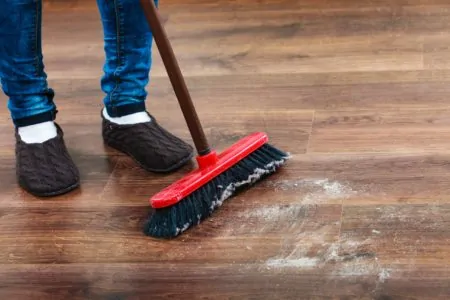Floors — we all have them, whether it’s tile, hardwood, carpet, or something else. But just because you walk all over them, does that make you super knowledgeable?
If you want to know more flooring statistics and facts, we have 40 to share. We’ll cover facts about the flooring market, some interesting information about wood floors and carpets, and some industry trends.
Before you know it, you’ll have dozens of facts under your belt and be in the know the next time you shop for new floors.
Top 10 Flooring Statistics and Facts
- The US flooring market size is 22.46 billion dollars in 2022.
- The driving force behind market growth is urbanization. Plus, people want to keep up with trends and lifestyle changes.
- The global market size is 257.92 billion dollars as of 2021. It’s expected to grow 5.6 percent by 2030.
- The rising population in developing countries is driving the global market growth.
- The key global flooring brands are Mohawk Industries Inc., Shaw Industries Group, Inc., and Tarkett S.A.
- Wood floors are good for allergies since they aren’t as porous as other floor types and are easier to clean.
- The wood flooring market size is expected to make 55.8 billion dollars by 2026.
- Carpets aren’t a hygienic flooring option. The fibers act as a filter, trapping chemicals, pollen, bugs, and dust.
- Vinyl flooring is on the rise since it’s affordable, resilient, and easy to clean.
- While carpets aren’t as popular, rugs are taking the market by storm.
U.S. Flooring Market
Let’s start by looking at the US flooring market. We’ll cover top companies, market size, and more.
- The US flooring market size: The US flooring market generated 22.46 billion dollars of revenue in 2022 (1). That’s the equivalent of each person in America spending roughly 67 dollars.
- The market will grow: The market is expected to grow by 4.57 percent annually between 2022 and 2026. That would bring it to a total of 26.86 billion in 2026.
- The US market is the biggest: The US is the top country for bringing in flooring revenue. They’re followed by China, Germany, then the UK.
- Main challenges: Currently, the biggest challenges in the industry include the price of raw materials. This makes it more expensive for suppliers and customers.
- Driving force of urbanization: One of the biggest drivers behind market growth is more urbanization. More people are building and remodeling homes, which demands more flooring. Another driving force is the desire to keep up with trends and lifestyle changes, which might affect a person’s flooring choice.
- Vinyl flooring has become more popular: The vinyl flooring market has increased steadily in the last 10 years. It’s a great, durable choice that doesn’t break the bank. This makes it excellent residentially, but it’s also a wise investment for hospitals, schools, and offices.
- Major players: The big names in the flooring industry include Mohawk Industries Inc., Shaw Industries Group Inc., and Armstrong Flooring.
- Eco flooring is on the rise: More customers and manufacturers are aware of the need for eco-friendly flooring. Natural flooring, carbon-neutral flooring, and non-toxic flooring are all becoming more popular. Amtico, Armstrong Flooring, Mohawk Industries Inc, and Tarkett are major players in this movement.
Global Flooring Industry
How does the global data compare with the US global industry? Let’s look at some of the most interesting worldwide flooring industry statistics.
- Global market size: The global flooring market generated 257.92 billion dollars in 2021 (2).
- Expected growth: The market is expected to grow by 5.6 percent between 2021 and 2030.
- Various flooring types: Overall flooring sales are generated by carpet, wood, laminate, luxury vinyl tiles, ceramic tiles, and more. The dominating flooring type is carpet, followed by wood and laminate.
- Biggest driving factor: The biggest drive behind increased sales is the rising population in developing countries. More people means more buildings, and with more disposable income, it’s more feasible to floor these properties.
- Aesthetics and ease are important: People’s desire for aesthetically-pleasing flooring is another driving force behind the market’s growth. People want to upgrade the style to match their preferences when they move into properties. Sales are increasing with more flooring becoming easy to install, such as stick-on tiles. Plus, many flooring options are now renter-friendly, allowing people to swap and change flooring as much as they’d like.
- The pandemic impact: During the first quarter of 2020, many people had to cancel their flooring plans (3). This was due to lockdowns and material shortages.In July 2020, a study found that over 85 percent of contractors were dealing with delays due to the pandemic. Sales dropped in 2020 but have been steadily picking back up.
- What might restrict the market: While the market is growing, a few things might hold it back. The main one is environmental concerns. There is a lot of waste in the flooring industry, which more sustainable customers and companies dislike. Proper waste management and recycling are a big priority. This will prevent infectious diseases, pollution, and drain obstructions.
- Key global players: The five leading global flooring companies include Mohawk Industries, Inc., Shaw Industries Group, Inc., Tarkett S.A., Armstrong Flooring, Inc., and Forbo Flooring Systems. Only two of those are non-US companies. Tarkett S.A. is a french company, and Forbo Flooring Systems is based in the Netherlands.
Wood Flooring Facts
Wood flooring is popular, durable, and stunning, and we’ve got eight facts to share about it and the industry.
- A hardness test measures wood floors: The Janka hardness scale measures how strong and durable a hardwood floor is. During this test, a steel ball is pushed into the wood. Experts will check out the wood’s ability to dent and wear. You want flooring with a hardness of around 1300. Some good choices include white oak, red oak, ash, American beech, and heart pine. The hardest woods are ipe, blackwood, and leadwood. The softest woods are Atlantic white cedar, basswood, and parota.
- Wood floors are good for allergies: If you, or someone in your family, has allergies, then you might consider wood flooring over carpet. Carpets collect all sorts of allergens, bacteria, dust, and even viruses. Wood flooring, on the other hand, isn’t as porous. It’s easier to clean and doesn’t cling to as many pests.
- Wood flooring lasts a lifetime: If you opt for a durable type of wood and take good care of it, your floors should last around 100 years.
- Wood flooring can make you money: When you install wood flooring in your home, it can up the resale value. Wood flooring is an excellent investment if you plan to sell your house further down the line.
- Global wood flooring market size: It’s estimated that the wood flooring market will make 55.8 billion dollars per year by 2026 (4). It’s becoming a more popular flooring type residentially but also in commercial and industrial buildings.
- Current wood trends: Popular wood flooring at the moment consists of wide, long planks in a lighter color. People prefer a matte finish rather than a glossy sheen, too. White oak floors are a great option if you’re into modern minimalism.
- Go for fake: There are some pretty impressive alternatives if you can’t afford real hardwood floors (we don’t blame you, they’re expensive). The top choices include laminate, engineered hardwood, vinyl plank, and tile that looks like wood.
- Wood is an eco-friendly choice: If you want to go green, choose wood. Firstly, it’s a renewable material. Secondly, it’s durable, so you won’t have to replace it often (or ever).It uses fewer materials to make, less energy, and more natural resources. You can go a step further by choosing manufacturers and retailers that sustainably source their wood.
Carpet Industry Statistics
Carpets are a huge part of the flooring industry. Here are some more carpet stats that may shock you.
- Carpets aren’t hygienic: Carpets are becoming less popular, and one big reason is that your carpets are full of chemicals, pollen, bacteria, bugs, and dust. The fibers act as a filter, trapping various pollutants.
- Carpets hold viruses for weeks: Many bacteria and viruses live in carpets and can survive for weeks. For instance, Norovirus can survive for six weeks within carpet fibers.
- Carpets off-gas: When you install a new carpet, you’re maybe enamored by that new carpet smell. But it’s actually toxic chemicals and substances within the carpet released into the atmosphere. This includes volatile organic compounds (VOCs), which can lead to nausea, asthma, headaches, and dizziness.
- Don’t choose a stain-resistant carpet: This probably isn’t music to your ears if you have kids. But stain-resistant carpets are made with fluorinated chemicals, which are unsafe, especially for babies and toddlers.
- Carpet industry size: The global carpet market was worth 51.9 billion dollars as of 2018. By 2026, it’s expected to be worth 73.9 billion dollars.
- Choosing the best carpet: If you want to opt for a carpet, it’s a good idea to choose one that’s durable and non-toxic. We recommend choosing one with the Green Label Plus logo. This means the carpet has lower VOC levels. Don’t choose a carpet with flame retardants, stain resistance, or other additives. Avoid synthetic carpets where possible. Go for natural fibers instead, like wool, organic cotton, jute, bamboo, or sisal.
- Consider these eco-friendly carpet companies: Some eco-friendly carpet companies to choose from include Earth Weave Carpet Mills, Sisal Carpet, and Carpets in Dalton.
- Clean carpets properly: Vacuum your carpets at least weekly, if not more often. You can steam your carpets to sanitize them, but don’t leave moisture behind after cleaning, as this can lead to mold and mildew. Get your carpets professionally cleaned twice a year.
Flooring Industry Trends 2022
We’ve spoken a little about a few trends here and there. But let’s investigate further some of the up-and-coming trends. You might even find a style you like!
- Vinyl flooring is on the rise: Vinyl flooring is becoming more popular. First of all, it is designed to look like anything you desire. It’s resilient, durable, and low-maintenance.It’s great for busy homes with kids or pets; plus, it’s comfortable underfoot.
- Custom and beautiful but affordable tiles: If you love tile floors, you might often be surprised by the prices. But tile can now look like anything, saving you money and bringing you glamor. You’ll find tiles that look like marble or in styles that resemble art deco and Moroccan.
- DIY, easy-to-install flooring: Flooring is becoming easier to install. Many companies are making stick-on flooring which is often water-resistant and super affordable. This is becoming incredibly trendy for retinal properties, so tenants have more freedom over their home’s aesthetic.
- People love rugs: While carpets may not be the first choice for many anymore, rugs are becoming popular. You might see more rugs over the next few years.
- Geometric patterns appearing: Long planks are still super popular, but geometric flooring is on the rise. Chevron and herringbone patterns are becoming trendy; they give a room a totally unique look.
- Rigid-core bamboo flooring: This type of flooring is up-and-coming. It’s gorgeous, durable, and eco-friendly. The rigid-core addition is also water-resistant, making it a great option for mudrooms, basements, and bathrooms.
- What colors are popular?: Besides flooring type, color preferences are changing. People are mainly looking for gray tones which look modern and contemporary. They basically suit any home, whether you have bright decor or something more neutral. Dark flooring remains popular due to its timeless quality.Finally, white tones are becoming more popular since it creates a bright, happy look.
- What people look for: A study found that the most important factor people look for in flooring is durability. This means that it’s going to last a long time, it’s easy to clean, and it’s suitable for homes with kids and pets. The next most important thing was aesthetics. People want their flooring to look good and make a statement.
FAQs
40 Fun Facts
With these 40-floor covering statistics and facts in mind, you’re sure to have learned something interesting about the flooring market.
We’ve covered the flooring market size — it’s worth billions — and some trends to look out for. If you’re in the market for new floors, you may want to consider something non-toxic and eco-friendly, like hardwood or natural linoleum.
Keep in mind that hardwood floors are the most durable. While they are expensive to install, they could last a lifetime, saving you money over the years.
